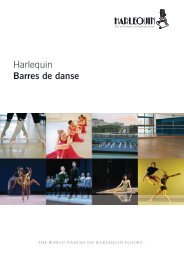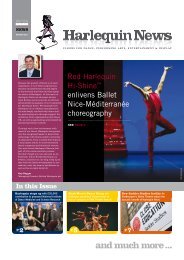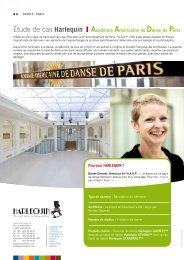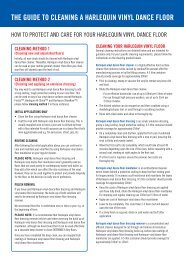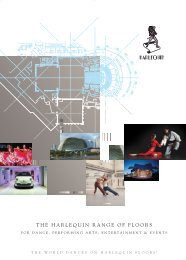The facts about sprung floors for dance - Harlequin Floors
The facts about sprung floors for dance - Harlequin Floors
The facts about sprung floors for dance - Harlequin Floors
You also want an ePaper? Increase the reach of your titles
YUMPU automatically turns print PDFs into web optimized ePapers that Google loves.
THE FACTS ABOUT<br />
SPRUNG FLOORS FOR DANCE<br />
Sprung floor manufactured by <strong>Harlequin</strong> at<br />
Schweizerische Ballettberufschule, Zurich.<br />
<strong>The</strong> development of <strong>dance</strong> floor technology has progressed significantly in recent years,<br />
thanks in no small degree to a strong relationship <strong>for</strong>ged between the <strong>dance</strong> community and<br />
industry to produce <strong>floors</strong> that are right <strong>for</strong> <strong>dance</strong>rs. <strong>The</strong>re has also been medical science<br />
research that has provided valuable insight into injuries to which <strong>dance</strong>rs are prone.<br />
Understanding the relationship between <strong>dance</strong>rs and <strong>dance</strong> <strong>floors</strong> has provided important input<br />
to <strong>dance</strong> floor technologists. Research is meanwhile continuing that additionally seeks to<br />
understand the contribution to artistic per<strong>for</strong>mance that a well-designed floor can offer <strong>dance</strong>rs.<br />
Two important factors that contribute to a floor that allows <strong>dance</strong>rs to per<strong>for</strong>m confidently and<br />
safely are the <strong>dance</strong> surface and the <strong>sprung</strong> sub-floor beneath. Expecting anyone to <strong>dance</strong> on a<br />
hard, unyielding surface can lead to a variety of ankle and shin stress related injuries that may<br />
also reduce a <strong>dance</strong>r's career in the longer term.<br />
Medical specialists in <strong>dance</strong> injuries have established a link between the quality of the floor and<br />
injury. A floor with a consistent degree of spring is strongly recommended. <strong>The</strong> second factor is<br />
the <strong>dance</strong> surface itself which should offer a degree of 'traction' that allows <strong>dance</strong>rs to be able<br />
to fully and artistically express their <strong>dance</strong> movements without the fear of slipping or falling<br />
due to a shiny or slippery surface.<br />
THE EVOLUTION OF SPRUNG FLOORS<br />
Historically the choice of per<strong>for</strong>mance surface was between a<br />
wooden floor and linoleum, until the advent of purpose developed<br />
vinyl <strong>floors</strong> during the 1970s. <strong>The</strong> desire <strong>for</strong> a floor with 'give' was<br />
accelerated by the fashion in ballroom dancing be<strong>for</strong>e and after<br />
World War II. <strong>The</strong>se <strong>floors</strong> often used coil or leaf springs and,<br />
as genuinely <strong>sprung</strong> <strong>floors</strong> were far too bouncy <strong>for</strong> ballet or<br />
contemporary artistic <strong>dance</strong> the need to provide semi-<strong>sprung</strong> <strong>floors</strong><br />
– particularly <strong>for</strong> ballet – led to considerable modifications. In the<br />
last 50 years metal springs have largely given way to resilient<br />
blocks or pads made of rubbers or polymers. With modern floor<br />
construction methods, the trampoline effect of the early <strong>sprung</strong><br />
<strong>floors</strong> has been suppressed.<br />
WHY DANCE FLOOR CHARACTERISTICS<br />
ARE DIFFERENT FROM SPORTS AND<br />
OTHER FLOORS<br />
It is a common assumption that a well-designed sports floor<br />
will suit the needs of <strong>dance</strong>rs. But there are two intrinsic<br />
differences – the construction of the <strong>sprung</strong> sub-floor and<br />
the per<strong>for</strong>mance surface. Along with some shock absorption,<br />
most indoor sports require a high degree of energy return<br />
and a requirement <strong>for</strong> adequate ball bounce. Evidently, <strong>dance</strong>rs<br />
have scant interest in ball bounce, but they are vitally focused<br />
in a different way on a combination of shock absorption and<br />
energy return that a <strong>sprung</strong> sub-floor can provide.<br />
<strong>The</strong>re are no hard and fast rules, but it is clear that female<br />
<strong>dance</strong>rs tend towards shock absorption – without any sponginess<br />
– whereas the men appreciate a <strong>dance</strong> floor with more spring<br />
<strong>for</strong> their often more energetic choreography.<br />
Indoor sports people by contrast can tolerate a stiffer floor<br />
as they usually have cushioned footwear – a luxury barred<br />
to <strong>dance</strong>rs. <strong>The</strong> main per<strong>for</strong>mance surface criterion<br />
<strong>for</strong> <strong>dance</strong>rs is slip-resistance, disconcertingly dubbed<br />
'traction' by many in the <strong>dance</strong><br />
community. Although sportspeople<br />
share the abhorrence of the risk of<br />
slipping and falling, they again are<br />
generally protected by their<br />
footwear from <strong>floors</strong> that<br />
might be considered a<br />
slip hazard <strong>for</strong> <strong>dance</strong>rs,<br />
<strong>for</strong> example some hardlacquered<br />
wood <strong>floors</strong>.<br />
Lower limb problems such as<br />
tendonitis, 'shin splints', knee<br />
pain and ankle strain can all<br />
be attributed to incorrectly<br />
specified <strong>sprung</strong> <strong>floors</strong> and<br />
can take several weeks of<br />
physiotherapy and recovery<br />
time to correct.
MAJOR SUPPORTER OF<br />
A BRIEF LOOK AT SOME RECENT AND<br />
CURRENT RESEARCH CONCERNING<br />
DANCE FLOORS<br />
Independent research has examined how <strong>sprung</strong> <strong>dance</strong> <strong>floors</strong><br />
can help <strong>dance</strong>rs reduce risks of injury and also provides new<br />
insight into per<strong>for</strong>mance related benefits.<br />
Dance scientist and biomechanics expert Luke Hopper's research<br />
investigated the effects of <strong>dance</strong> <strong>floors</strong> on <strong>dance</strong>r per<strong>for</strong>mance<br />
and injury. Various <strong>floors</strong> used by professional <strong>dance</strong>rs in the UK<br />
were tested and it was found that only the <strong>floors</strong> specifically made<br />
<strong>for</strong> <strong>dance</strong> complied with the standards <strong>for</strong> hardness. <strong>The</strong>re<strong>for</strong>e<br />
requiring <strong>dance</strong>rs to per<strong>for</strong>m on <strong>floors</strong> that are not <strong>dance</strong> specific<br />
may present an unnecessary injury risk. Luke Hopper is lecturer<br />
of exercise and clinical biomechanics at the University of Notre<br />
Dame, Fremantle and is now investigating <strong>dance</strong>rs' perceptions of<br />
varied <strong>dance</strong> floor surfaces and the relationship between various<br />
floor mechanical properties and perceptions of floor injury risk<br />
and per<strong>for</strong>mance qualities.<br />
Surgeon Boni Rietveld, MD Head of <strong>The</strong> Dutch Medical Centre<br />
<strong>for</strong> Dancers and Musicians, <strong>The</strong> Hague, Co-Founder of <strong>The</strong> Dutch<br />
Per<strong>for</strong>ming Arts Medicine Association states: “It is as dangerous to<br />
<strong>dance</strong> on a hard floor as it is to constantly <strong>dance</strong> on different<br />
types of floor. <strong>The</strong> best preventative method will always be the<br />
installation of a correct <strong>dance</strong> floor. In my opinion, a <strong>dance</strong><br />
floor should be neither too supple nor too soft. A hard floor has<br />
the effect of causing serious return shock waves and can bring<br />
<strong>about</strong> injuries or premature wear in the cartilage.” Starting in<br />
September 2010, Dr Boni Rietveld will commence a research<br />
project with the Conservatoire de Paris and <strong>Harlequin</strong> Europe<br />
SA to compare traditional basket weave <strong>floors</strong> with a <strong>Harlequin</strong><br />
<strong>sprung</strong> floor panel system.<br />
James Hackney PT, PhD, Sara Brummel MFA, Kara Jungblut<br />
SPT and Carissa Knoderer SPT. Physical <strong>The</strong>rapy Department<br />
of Missouri State University investigated the effect of <strong>sprung</strong><br />
(suspended) floor on leg stiffness and vertical ground reaction<br />
<strong>for</strong>ce during grand jeté landings in ballet. For eleven out of the<br />
thirteen <strong>dance</strong>rs who participated, the leg stiffness was increased<br />
in landing grand jeté on the <strong>sprung</strong> floor. In each of the <strong>dance</strong>rs<br />
who showed this effect, the total leg compression (joint flexion)<br />
was less on the <strong>sprung</strong> floor than on the energy-returning floor.<br />
This implies a lower requirement on the <strong>dance</strong>r's landing leg in<br />
absorbing the <strong>for</strong>ce of landing, and by extension, supports the<br />
notion that a <strong>sprung</strong> floor may be helpful in reducing the rate of<br />
musculotendonous injury associated with the task that we studied.<br />
SPRUNG FLOOR CONSTRUCTION<br />
<strong>The</strong>re are three main types of <strong>sprung</strong> <strong>dance</strong> floor that vary in<br />
how the <strong>sprung</strong> sub-floor is constructed.<br />
• Basket weave construction <strong>sprung</strong> floor.<br />
• Fully floating <strong>sprung</strong> floor composite construction.<br />
• Sprung panel construction.<br />
Each of these is completed with a vinyl <strong>dance</strong> surface, selected<br />
from a range of options to suit the principle <strong>dance</strong> styles <strong>for</strong> the<br />
particular facility.<br />
Installation at Laban<br />
Basket weave at the Scottish Ballet<br />
‘‘<br />
It is as dangerous to <strong>dance</strong> on a hard<br />
floor as it is to constantly <strong>dance</strong> on different<br />
types of floor. <strong>The</strong> best preventative method<br />
will always be the installation of a correct<br />
<strong>dance</strong> floor.<br />
Cellular<br />
polyurethane layer<br />
‘‘<br />
First layer of<br />
semi-flexible panels<br />
Surgeon Boni Rietveld, MD Head of <strong>The</strong> Dutch<br />
Medical Centre <strong>for</strong> Dancers and Musicians,<br />
<strong>The</strong> Hague, Co-Founder of <strong>The</strong> Dutch Per<strong>for</strong>ming<br />
Arts Medicine Association<br />
Top semi-flexible<br />
panel layer with<br />
joints staggered<br />
<strong>Harlequin</strong> vinyl<br />
per<strong>for</strong>mance surface<br />
A White Paper – <strong>The</strong> Facts <strong>about</strong> Sprung<br />
<strong>Floors</strong> <strong>for</strong> Dance – can be downloaded at<br />
www.harlequin<strong>floors</strong>.com<br />
British <strong>Harlequin</strong> plc, Festival House, Chapman Way, Tunbridge Wells, Kent TN2 3EF<br />
Tel: +44 (0) 1892 514888 Fax: +44 (0) 1892 514222<br />
Email: enquiries@harlequin<strong>floors</strong>.com www.harlequin<strong>floors</strong>.com<br />
c<br />
LONDON LUXEMBOURG PARIS MADRID LOS ANGELES PHILADELPHIA FORT WORTH SYDNEY HONG KONG



